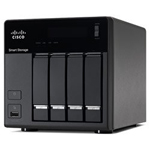
NAS Storage - Moving Forward,
Backing Up
used with permission from
the Cisco Small Business Site
 NAS storage appliances
can give your business terabytes of additional storage capacity, while
providing automated, redundant data backups. Today's NAS storage systems
require minimal maintenance, reduce data storage costs, and provide fast
file access from a centralized, secure data repository.
NAS storage appliances
can give your business terabytes of additional storage capacity, while
providing automated, redundant data backups. Today's NAS storage systems
require minimal maintenance, reduce data storage costs, and provide fast
file access from a centralized, secure data repository.
What to Look For in an NAS Storage Solution
The top features you should look for in an NAS storage appliance include:
- Redundant data
backup. Ideally, you should be able to set up your NAS storage
appliance as a RAID system. For example, in a RAID1 configuration, the
same data is simultaneously stored on two hard drives. If one drive
crashes, the data is still accessible from the second.
- Fast data
backup/restoration. For maximum performance, your NAS storage
appliance should support the Gigabit Ethernet
interface.
- Lockability. For
extra data security, get a NAS storage appliance with a lockable front
panel, to prevent theft or tampering.
- Small size and quiet
operation. Some network storage appliances are small enough to fit
on a shelf. Ideally, look for a quiet appliance that will not disturb
nearby workers.
- Support for Microsoft
Distributed File System (MDFS). This feature lets you map multiple
storage devices so users see them as one drive. Users do not have to
remember which drive their data is stored on.
- Automatic file
encryption/decryption. This feature protects data if a hard drive
within the NAS system is stolen. For robust security, look for an NAS
solution offering 256-bit AES file encryption.
- The ability to constantly backup from multiple computers. This feature can be centralized in a network storage appliance. You will simplify backup management, while helping to ensure that you do not lose valuable information.
Please contact your Databranch sales representative to discuss your Network Attached Storage (NAS) needs. We are happy to help you map out your next step in securing backups.